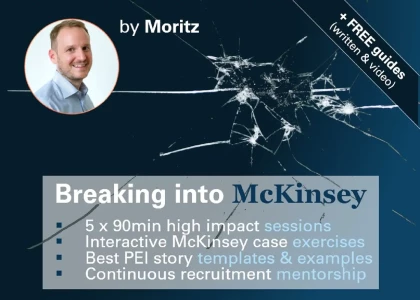Do any of the coaches have any recommended materials to practice structuring drills? I am looking for materials to do some independent practice
Structure drills


Hi there,
Some good answers already so let me complement with an important distinction between frameworks, namely those organizing “areas of analyses” and other organizing “specific ideas”. Candidates very often get this super wrong!
- Areas of analyses: If there's an overall objective in the case prompt, and you have not much background information yet, your structure serves as a guide that organizes area of analyses. This means a list of things you'd like to explore in the next 30 min in order to better understand the problem and subsequently devise a solution. You need to be pragmatic and have a hypothesis as to what the top areas to look into should be, because you can't “boil the ocean” and analyze everything in 30 min. In this case, your structure is the roadmap for the interview and every end-point of your MECE structure is an area you'd like to investigate going forward.
- Specific ideas: Alternatively, you may be asked for a structure to provide some ideas. At McKinsey for example, the first question is often a version of “What do you think are some of the factors affecting [something specific relating to the prompt]. In this case, you shouldn't create a framework to organize areas you'd like to explore. Instead, you should give very specific examples of whatever was asked e.g. factors, ideas, reasons, etc. For example, if profit is down in an airline, don't just create a revenue bucket and say you want to look at price and number of tickets sold. Those are not ideas! Those are areas of analyses! A much better answer would include a long list of detailed reasons as to why either revenue was too low or costs too high. In this case, every end-point of your MECE issue tree is an idea, which is ultimately a mini-hypothesis at the most granular level.
All of the above can be trained through the resources already mentioned by other coaches. In addition, I would urge you to create your own mini cases during the day, under the shower, or when falling asleep. For example:
As you walk through the city park, you see a person selling coffee out of their Piaggio Ape. This used to be great business but profits have declined lately. You were brought on to help out!
Depending on the next question you ask yourself, you should use a different approach:
- What are some ideas to turn things around? (specific ideas approach)
- Why might this happening and how can it be fixed? (areas of analyses approach)
Hope this helps a bit! Best of luck!

Hi there,
A few tips:
- Preplounge has a new feature for structuring/frameworking drills!
- Stay away from Rocketblocks frameworking drills (they're horrible)
- Casebooks
- “Live” frameworking practice (i.e. day to day)
- Reading BCG + McKinsey Insights
- Coaching
Frameworking Intro
How do I use frameworks in a case?
If there's anything to remember in this process, is that cases don't exist just because. They have come about because of a real need to simulate the world you will be in when you are hopefully hired. As such, remember that they are a simplified version of what we do, and they test you in those areas.
As such, remember that a framework is a guide, not a mandate. In the real-world, we do not go into a client and say "right, we have a framework that says we need to look at x, y, and z and that's exactly what we're going to do". Rather, we come in with a view, a hypothesis, a plan of attack. The moment this view is created, it's wrong! Same with your framework. The point is that it gives us and you a starting point. We can say "right, part 1 of framework is around this. Let's dig around and see if it helps us get to the answer". If it does, great, we go further (but specific elements of it will certainly be wrong). If it doesn't, we move on.
So, in summary, learn your frameworks, use the ones you like, add/remove to them if the specific case calls for it, and always be prepared to be wrong. Focus rather on having a view, refering back to the initial view to see what is still there and where you need to dive into next to solve the problem.

Hi there,
Problem structuring, the famous frameworks, is about breaking down the problem into logical and manageable pieces that allows you to scope the problem, define the key question and clearly communicate to the interviewer how to move on.
I would recommend to check once again the material available on Preploung on type of the cases: https://www.preplounge.com/en/bootcamp , at least to familiar yourself with the different elements by type of the case to move from there building customized frameworks (as we do at MBB)
Then practice with peers and eventually invest in coach.
Last piece of advice I am giving my coachees is: you can approach it like if you should write a plan of what all the steps you would do if you would be given this project. Once you have this validated with the interviewer you start solving the case following your plan.
Good luck!
Lucie
Was this answer helpful?

Hi there,
Great question! A few tips:
- Aim to practice only the framework question across multiple cases. Do the best that you can in answering it on your own and then check the solution. Try to understand how the solutions offer a more sophisticated answer to your and learn from it.
- Aim for quality practice over doing many cases.
- Try and understand how the structuring actually works instead of memorising different types of structures.

Building on the other experts suggestions on the method (I agree on those), below some sources of case prompts to practice structuring
- MBA Casebooks (I like Wharton, Tuck for example)
- Preplounge Cases
- McK, BCG, Bain sample cases available online
- “Usual suspects” books for additional case preparation (Case in Point - bit simplistic maybe , Victor Cheng)
Hope this helps.













